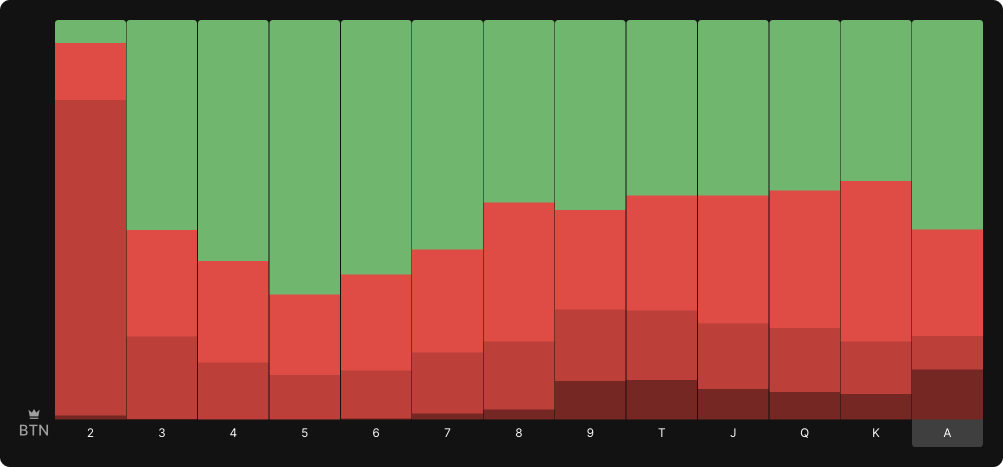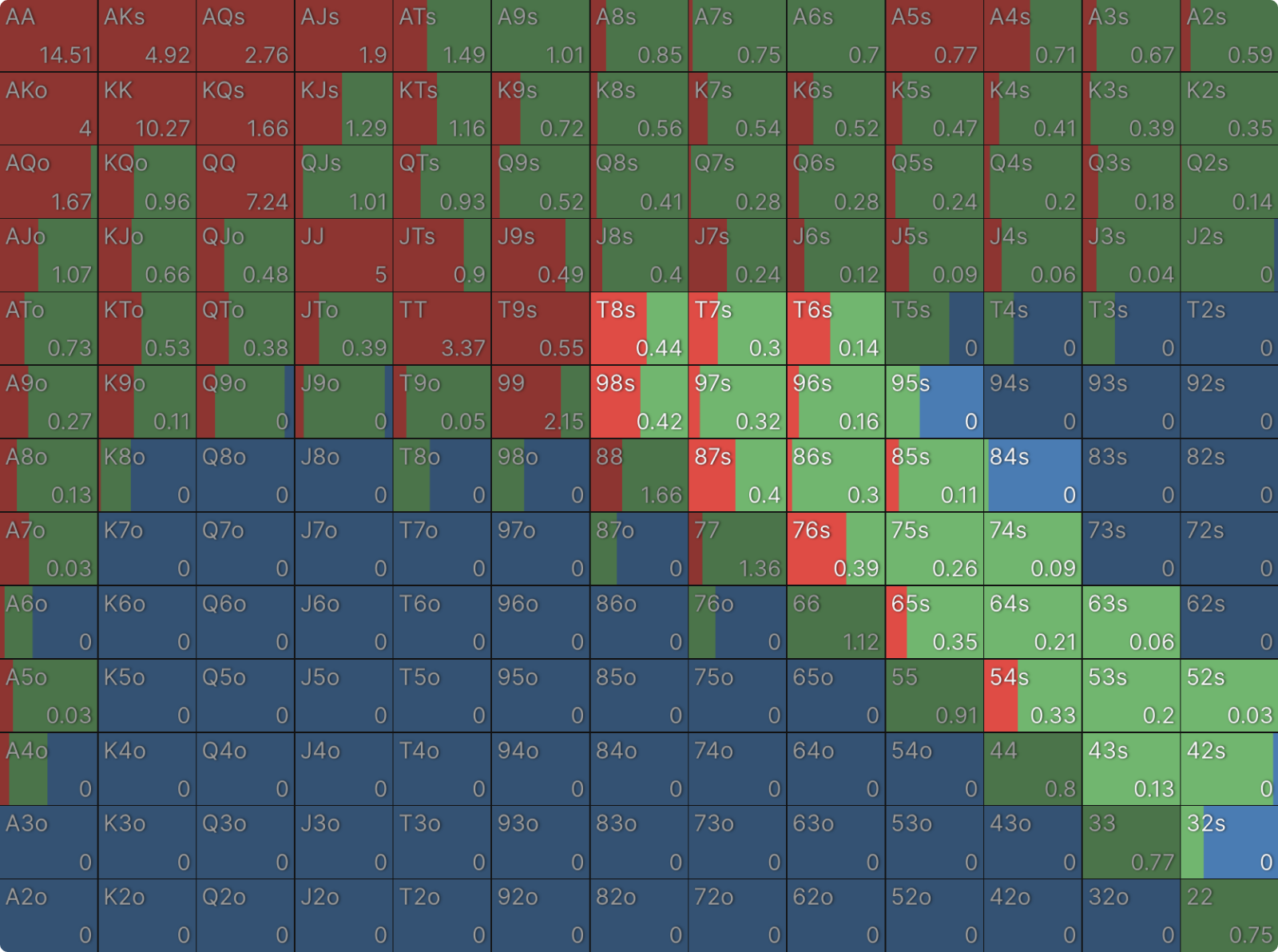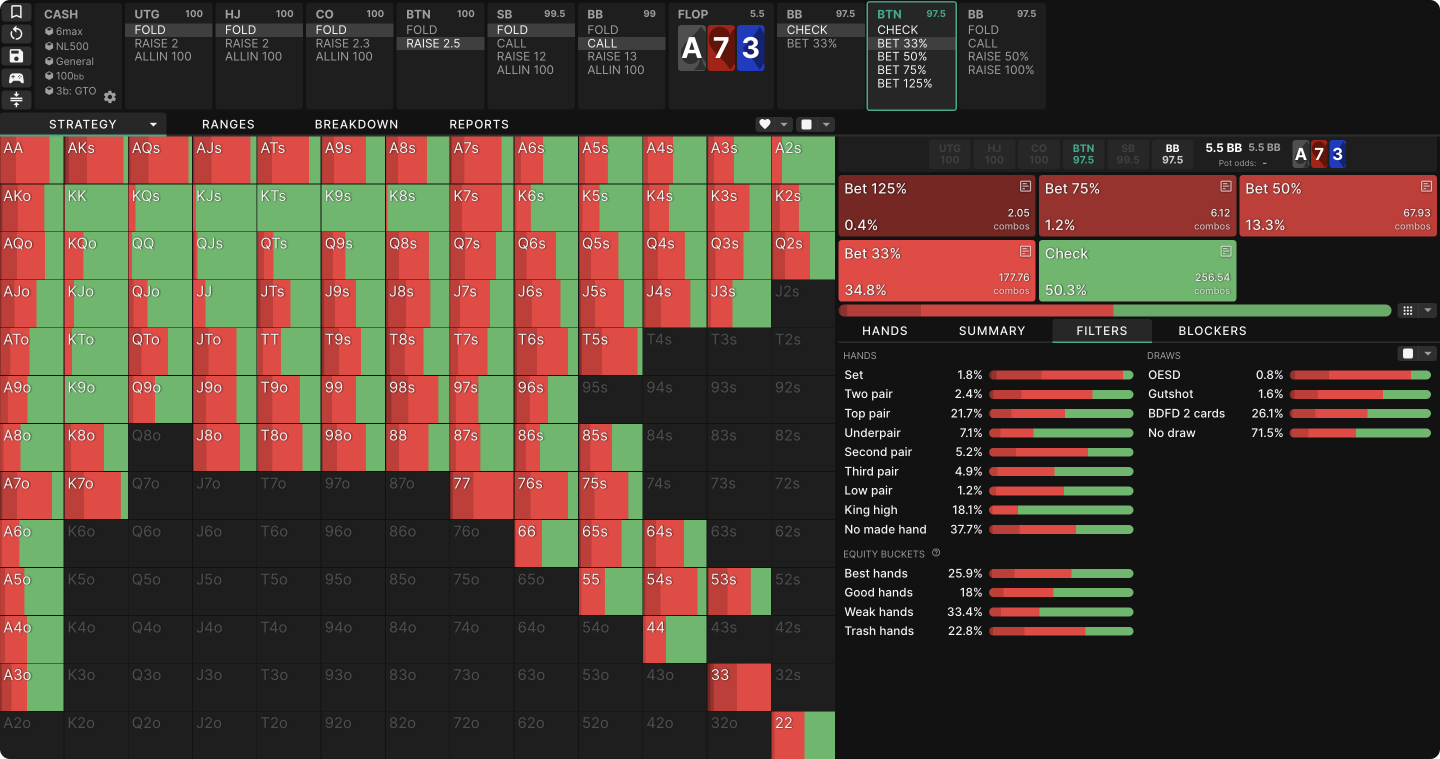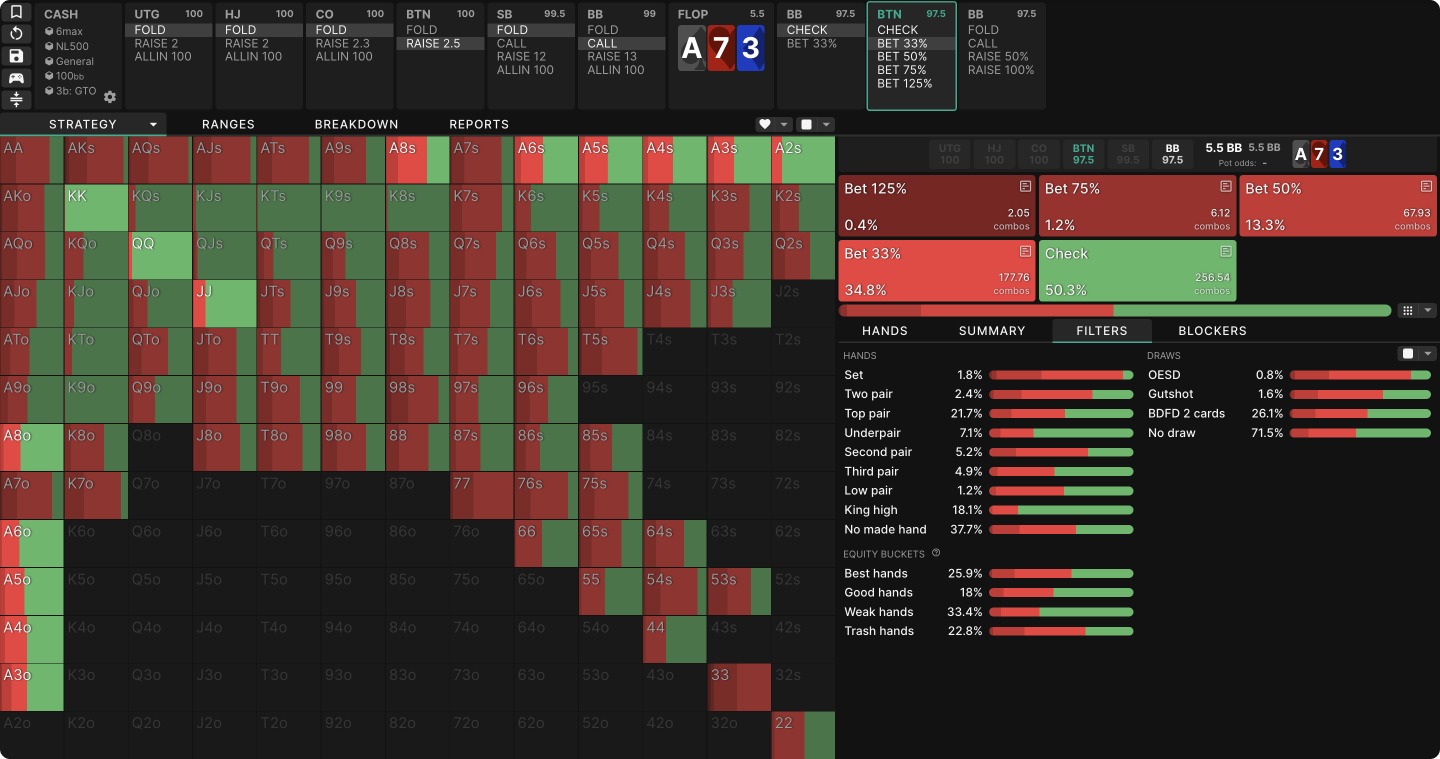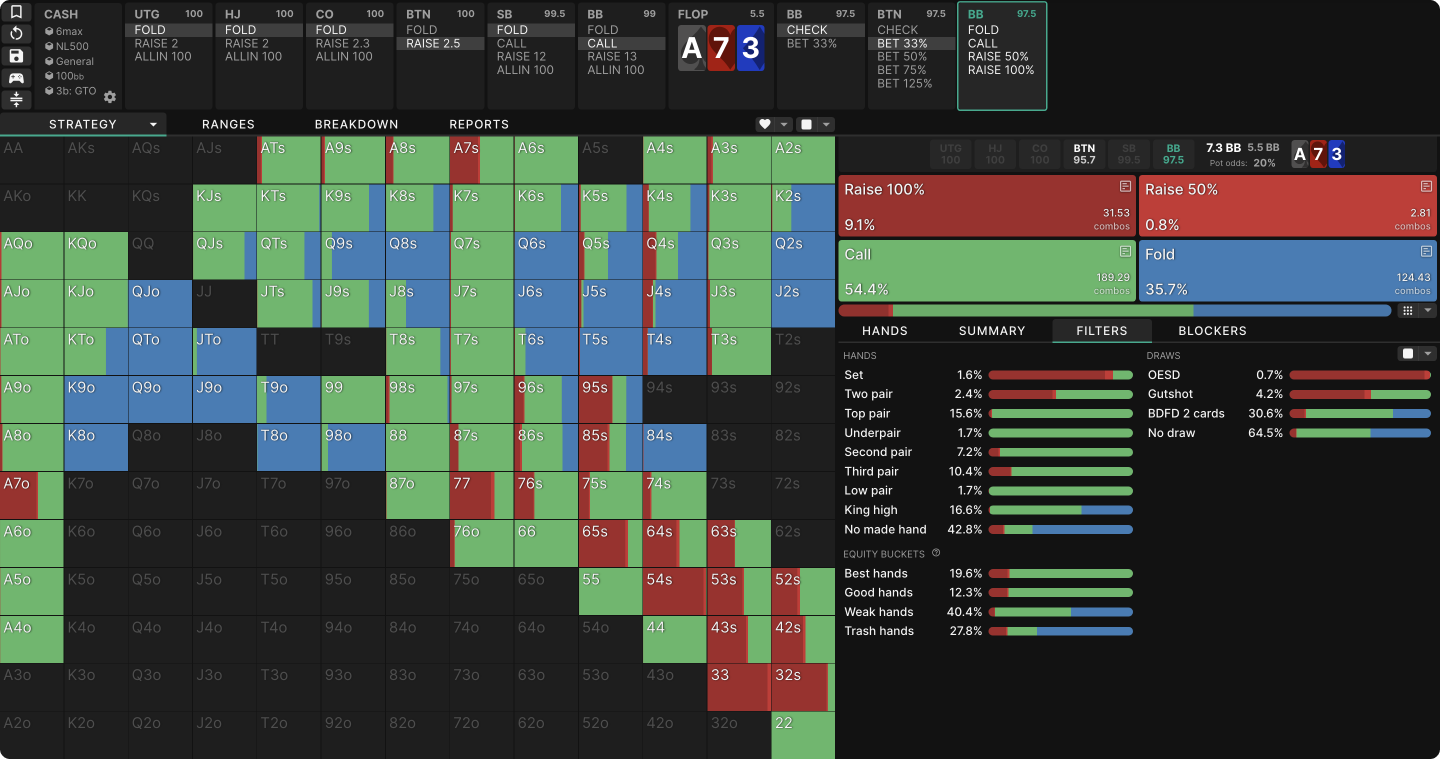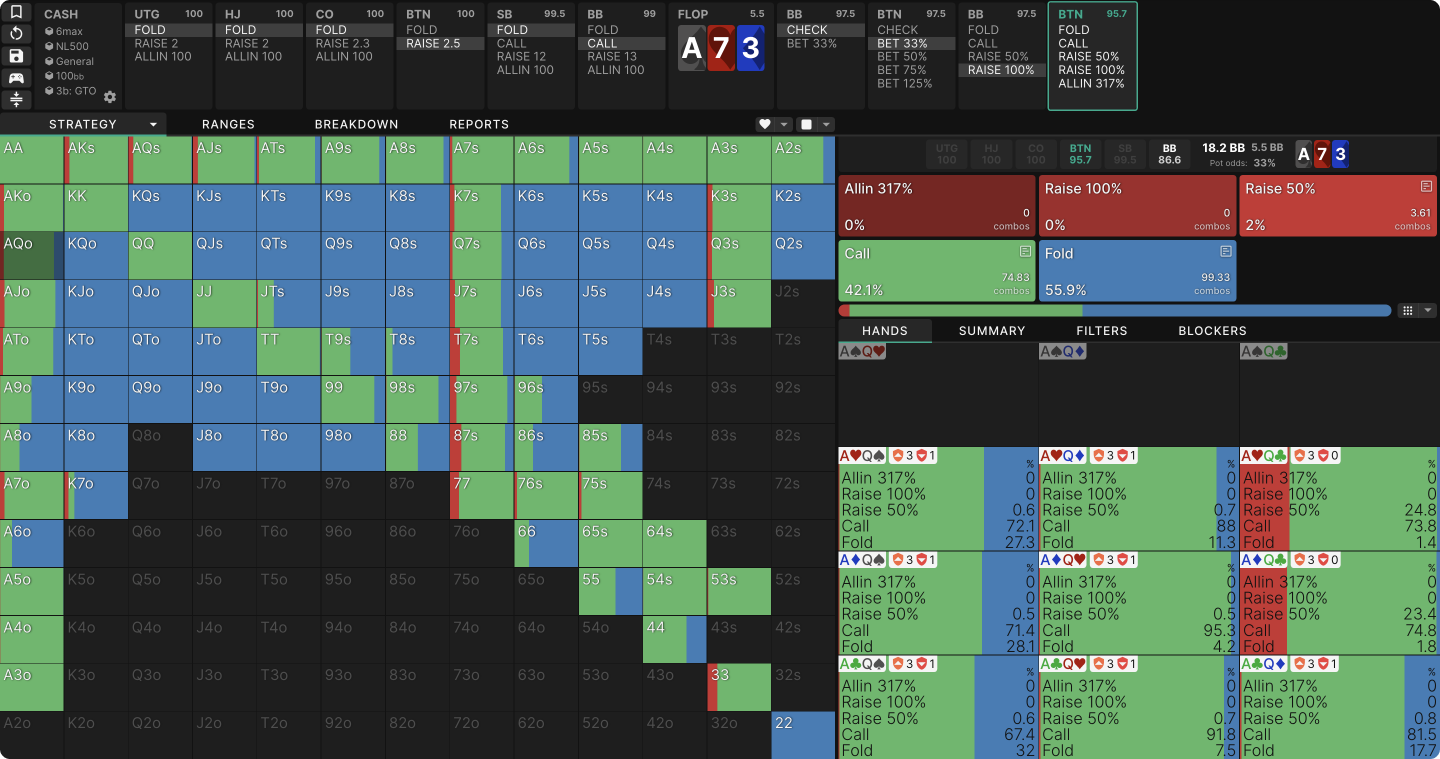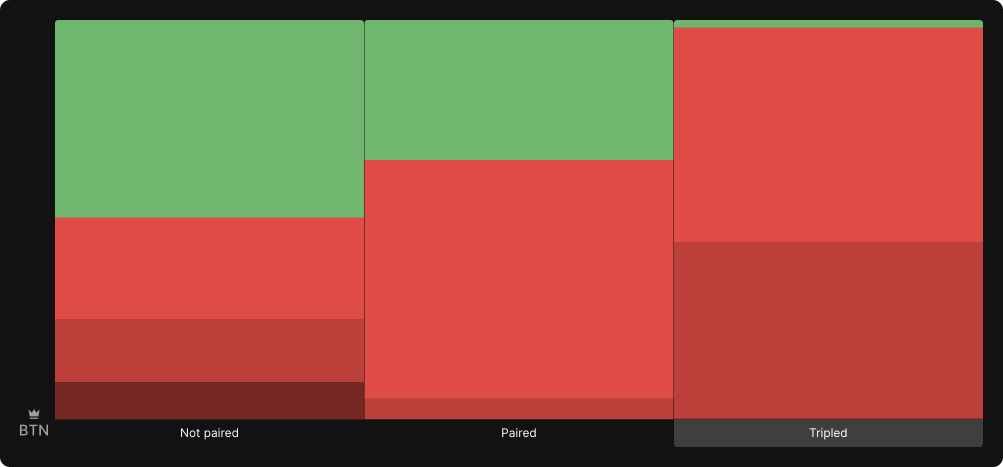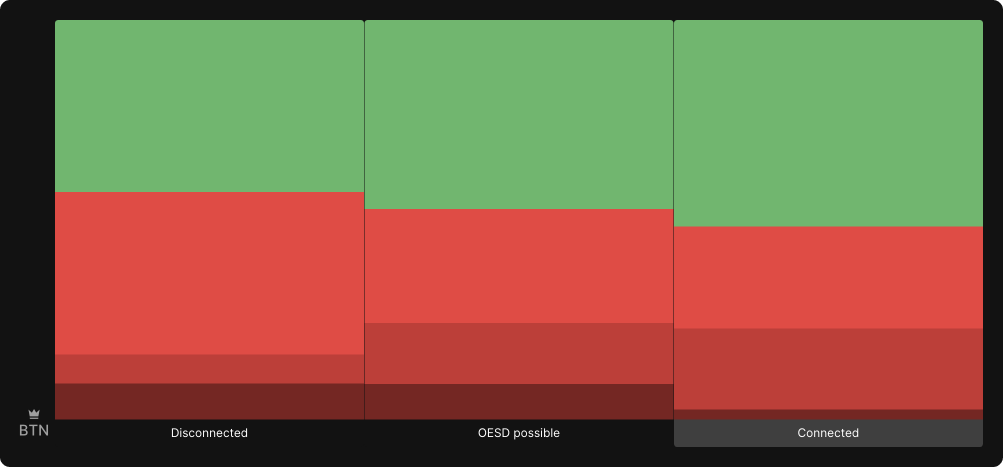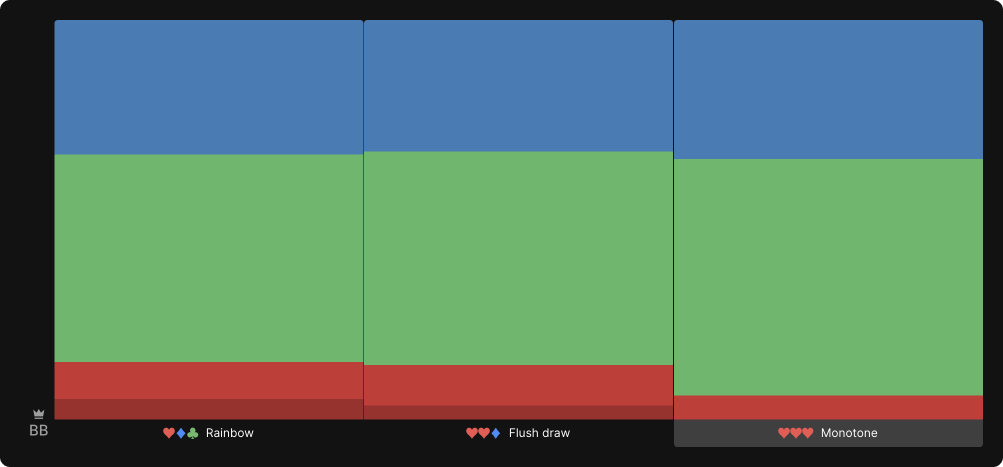Flop Heuristics: IP C-Betting in Cash Games

Our never-ending quest for money and fame leads us to the flop. We open the button, the big blind calls and the dealer throws out three community cards. After a twenty second tankTank
The act of taking a long time to make a decision.
on KT3r, action is kindly checked over to us. Now what?
This article will look at various IP C-Betting strategies against a BB caller. We’ll learn which factors affect our frequency and bet sizing, and examine a few flops along the way.
Understanding Ranges
Having a solid understanding of how preflop ranges connect with different boards is crucial in building effective postflop strategies. So, what should our first steps be when analyzing how our, and our opponent’s range, connect with a flop?
Quoting directly from Andrew Brokos’ article Flop Heuristics: IP C-Betting in MTTs’, He states that when acting as the preflop raiser, rather than focusing on the question “Which of us is more likely to hit this flop, me or my opponent?” we should instead ask ourselves “How does this flop improve my opponent?”
This small yet important distinction fosters the right mindset as the preflop aggressor. Not only has our opponent declined to 3-bet preflop, leading to them missing many of the strong hands at the top of their range, but their range is wide as well because of the blinds. The combination of these two factors means that we will have an advantage over our opponent on nearly every board, even scary ones!
Understanding Textures
Poker is home to a wide variety of flops, 1755 strategically distinct ones to be exact! Even for experienced players, this number is overwhelming. GTO Wizard’s aggregate reports make this more manageable by allowing us to categorize flops and look for common patterns.
Grouping Flops
Let’s use GTO Wizard’s flop grouping tool! For this analysis, we’ll use the most common postflop formation, BTN vs. BB. The following chart shows the BTN C-Betting frequency on different boards grouped by high card. Note that this is a Simple solution, meaning that BB is not allowed to donkDonk
A short form for the word donkey, used pejoratively to describe a weak or bad player..
Watch out!
Something that quickly pops out is that 2 high flops are bet the most. Do not be fooled! This is not because the 2 is necessarily good for us, but instead, because the only possible 2 high flop is 222, which is good for us. It’s similarly impossible to have a 3 high flop without the board being paired at least once. Ace-high flops are most likely to occur, followed by King-high flops and so on.
Why are high cards bet more?
As the preflop raiser, we are more likely to open hands that contain high cards like an Ace, King, or Queen. Conversely, we play fewer hands with low cards, such as 5 or 6. While the BB also prefers to hold higher cards, a large portion of their range consists of low card holdings because of the preflop discount posed by the blinds.
We connect better with high card boards and get to bet more.
A Surprising Discovery
Looking once again at the grouping by high cards chart, we see that Ace High flops are seemingly bet less often than 8 through King-high flops.
Why is this?
The answer comes down to several factors:
The Decreased Value of Fold Equity
On a K73 or Q73 board, there is an incentive to bet a marginal top pair holding (e.g. K8, Q9) to protect or gain value from our opponents’ overcards. However, on an Ace-high board, there is no need for AceX to protect against overcards; anything that isn’t a draw is nearly dead. This lack of urgency causes hands like marginal AceX – which can often only get one or two streets anyway – to delay to the turn or river in hopes of seeing a safe runout.
Additionally, the big blind has a large amount of AceX in range as well, causing bets with hands like KK and QQ to cut equity much quicker.
The Ace Polarizes the BB’s range
On an Ace-High board, the big blind often lacks middling hands; they connect or completely miss. This polarity causes a proportionally large amount of continues as a check-raise as opposed to a check-call. This can be problematic for IP, because OOP often uses a large check-raise size with 2-pair+ and bluffs. This check-raise will often cause even IP’s strong Top pair to become immediately indifferent on the flop.
Let’s now put knowledge to work on an Ace-high flop.
A73 Rainbow: A Case Study
Rather than always looking at bets, another great way to analyze a flop is by looking at checks.
Top Pair Weak-kicker AceX and KK–JJ all check back the flop at a significantly higher frequency than the rest of the range. These types of hands have low incentive to bet the flop as it is unlikely they’ll get outdrawn. Betting too often with this hand class leaves IP vulnerable to check-raises, which will happen increasingly often as IP chooses to bet more of these marginal holdings.
KingX with a good kicker is another commonly checked hand class. To understand this, think about what betting a hand like KJ accomplishes. Most hands that will fold, like K8 or JT, already have very little equity against KJ. You then also won’t be able to get value from these hands on a turned King or a Jack. Betting will also increase the proportion of strong hands like AJ and KQ in range in OOP’s range, weakening your outs.
Let’s examine BB’s response to a flop C-Bet.
OOP only ever uses a large raise sizing on this flop consisting of 2-pair+ for value. Most of the bluffs consist of straight draws and weak board pairs.
Facing the raise, hands as strong as AQ are made indifferent. Hilariously enough, strong pocket pairs often prefer calling over AceX as they have more outs to improve and cooler OOP’s tight value range.
Flop Pairing
Paired flops are bet significantly more often than unpaired flops. However, they tend to only be bet for small sizing. This is mostly due to our preflop equity advantage but reduced nut advantage from trips being in both player’s ranges. On paired boards, it’s also much harder to have a draw. This makes it very hard to continue and realize equity against a small bet. The higher the pair and the more disconnected the board is, the larger our advantage and betting frequency as the preflop aggressor will be.
Flop Connectivity
GTO Wizard classifies a flop as connected if it allows for the possibility of a flopped straight.
Disconnected
Disconnected boards are the hardest for either player to connect with. This preserves IP’s preflop advantage better than other board types. This texture sees the frequent use of the 33% sizing, but the 130% sizing is common as well.
OESD possible
What classifies as a strong hand on an OESDOESD
A straight draw where the player already has four consecutive cards, using the board and their hand, and will make a straight if a card at either end their four completes; an 8-out straight draw. For example, a player with 56 on a board of 78K2 has an open-ended straight draw as they have 5678, and will this make a straight on either a 4 or 9 river. Also frequently described as simply being open-ended. possible board (Open-Ended Straight Draw) is likely to change on later streets, so sizing up for additional fold equity and protection on the flop can be a good play. This board texture sees the increased use of the 66% pot bet size, but decreased overall betting frequency due to our newfound polarity.
Connected
Connected boards are a unique case due to flopped straights often being in the BB’s range. In order to be respectful of this, we size down; Connected boards see the least amount of the 133% pot sizing.
Flop Suits
Suited flops follow a similar trend to connected flops. Rainbow flops, being the hardest for either player to connect with, are bet most frequently. Flush draw flops see a decrease in overall betting frequency but a slight increase in polarity. Finally, monotone boards see a DRASTIC decrease in betting frequency and sizing.
Monotone Boards: An Overview
Monotone boards significantly hinder the nut advantage of the IP player. We can see this by sorting by EV.
This is due to all the flushes within our opponent’s range jumping ahead of our strong preflop hands; but there are some additional factors that lower the flop betting frequency.
On Monotone flops, holding a flush blocks the opponent’s calling range:
On a K♥9♥5♥, holding A♥T♥ will block a significant amount of the opponent’s continuation range, making it harder to get value. Because of the flush on board, the opponent will no longer be able to defend hands like JT and QT without a heart. Facing a double barrel, the opponent will begin to fold hands as strong as top pair without a heart!
This explains the very low flop check-raise frequency relative to other board textures. The primary hand that wants to raise for value is a flush which blocks the calling range!
Furthermore, betting doesn’t necessarily gain you protection from the various flush draws. A good player will not fold a heart on K♥9♥5♥ to a small bet, and sizing up serves to only serves to quickly isolate yourself against the top of your opponent’s range.
Low flushes are vulnerable to a fourth heart
It’s often very reasonable to check back a low flush on the flop. While definitely strong enough for 3 streets on a clean runout, not all runouts will be clean.
The primary hand that wants to get value by raising is a flush, and the flush blocks the calling range! This also helps us make sense of strategies on later streets as well. IP often has a hard time sizing up on the turn due to the sheer amount of flushes left in OOP’s range.
- A common low flush strategy is checking back the flop, betting something around half pot on the turn, and then 2x potting the river once a clean runout has been confirmed.
- Double high card flushes can also make reasonable flop check backs because they block so much of the continuing range.
- High and low card flushes (A2♠, K6♠) often make for the best bets. They don’t block as many calls and need not wait for a safe runout because they maintain their strength, even on a 4th heart.
Conclusion
Let’s recap some key points about continuation betting in single-raised pots.
- C-Bet more on high card flops that maintain your advantage as the preflop aggressor.
- C-Bet more on paired and disconnected flops.
- Polarize with larger and less frequent bets on flops where draws are present but not yet completed.
- Size down and bet less on flops that complete straights and flushes in your opponent’s range.
Thanks for reading this far! We hope you’ve learned new ideas you can apply into your game. Flop strategy is an incredibly broad topic, so here are few follow-up resources to further improve your understanding:
Author
Madmanslime
Steven Zahr is an up-and-coming mid-stakes cash game player with a knack for understanding and dissecting GTO solutions.

